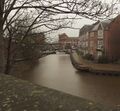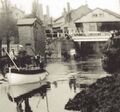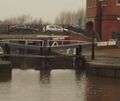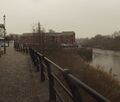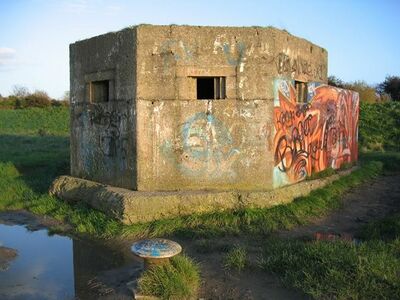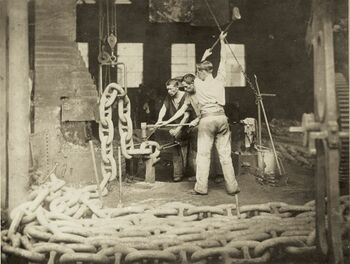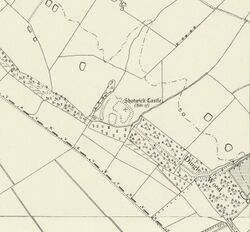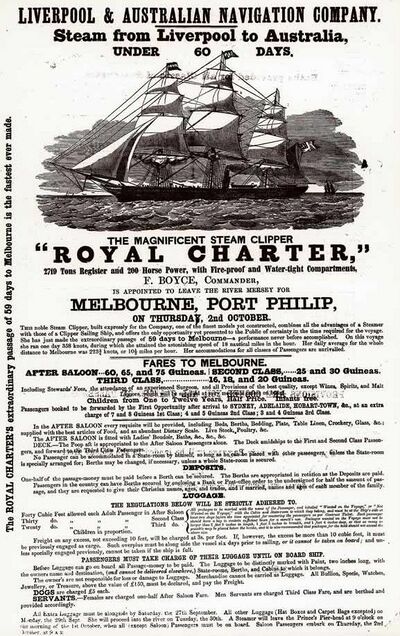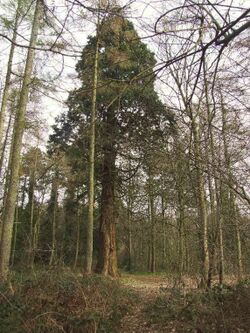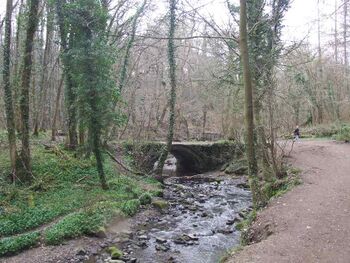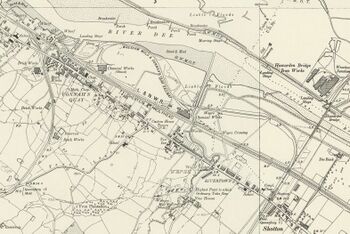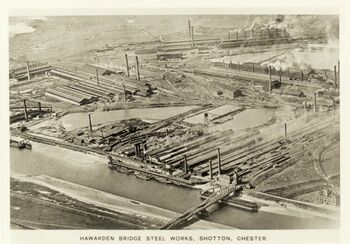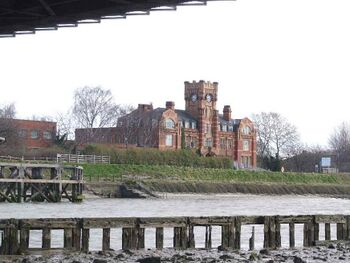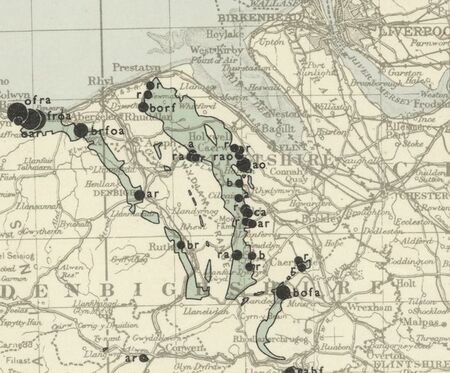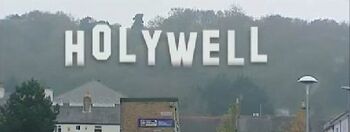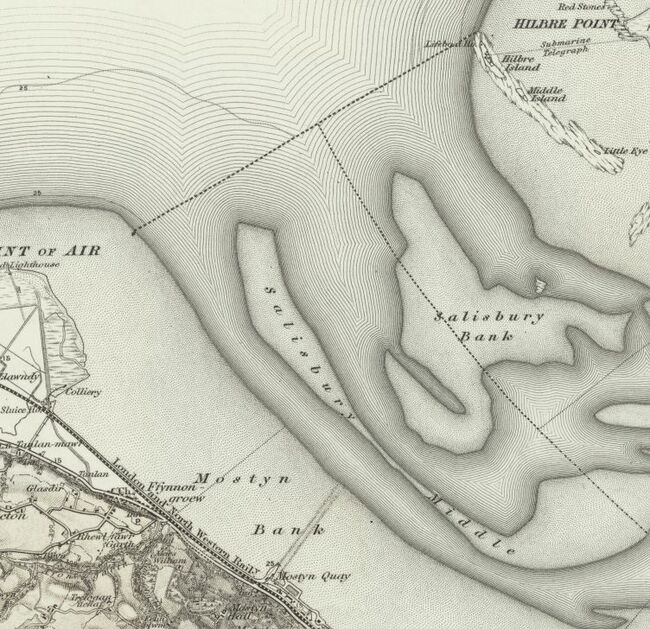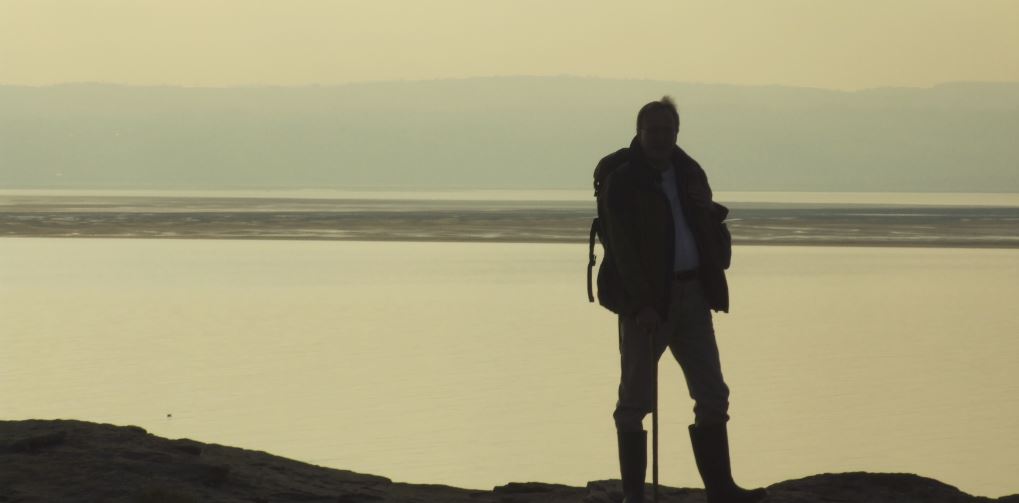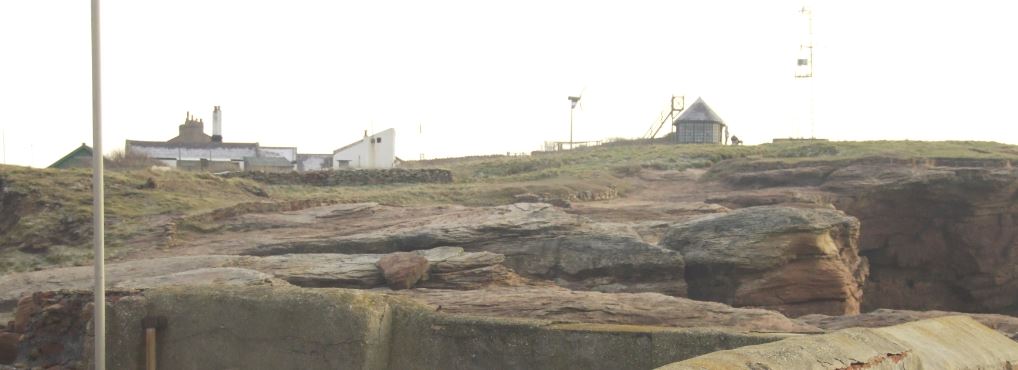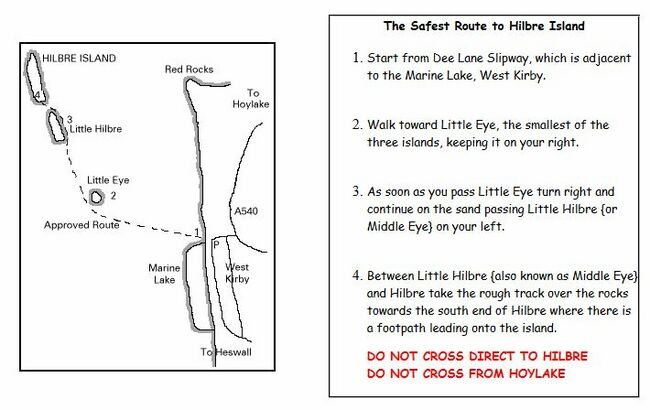Lower Reaches
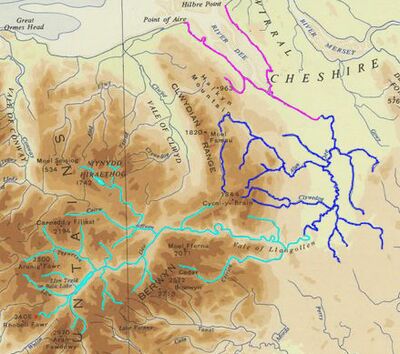
We have divided the story of the River Dee into three parts:
Upper Reaches
From the source of the river at springs on the slopes of Dduallt above Llanuwchllyn in the mountains of Snowdonia, through Wales, to its emergence from the Vale of Llangollen; here the young river flows swiftly and the majority of erosion takes place, cutting relatively narrow, steep-sided, "V"-shaped valleys, often with interlocking spurs.
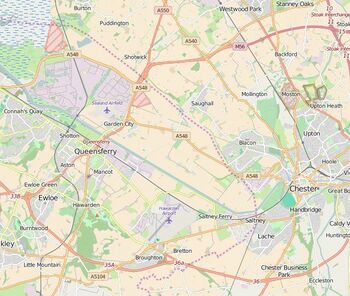
Middle Reaches
Through England and the Welsh borders to Chester; the "middle aged" river slows down and the valley becomes broader. Both erosion and deposition of material takes place, leading to the formation of meanders and occasional changes of course which have in cases left pockets of England "stranded" on the Welsh side of the River Dee.
Lower Reaches
Back in Wales, below Chester to Hilbre Islands and the sea; the river is now in "old-age" and while there is little erosion a lot of material is deposited. In the case of the River Dee this deposition has had a significant impact on the economic development of Chester, effectively turning a major port into a relatively quiet backwater. The estuary is important for birdlife and has been designated both as a "Site of Special Scientific Interest" and under the "Ramsar Convention" on "Wetlands of International Importance", especially as waterfowl habitats.
Estuarine Silting
The lower part of the Dee and in particular the estuary has commonly been referred to as the "Chester River" to avoid confusion with other rivers of the same name, particularly the Dee in Scotland. Due to shifting shoals and channels recent local knowledge is essential for the tidal section of river together with British Admiralty charts numbers 1953 (larger scale) and 1978. A Leisure edition of the latter chart is available. Downstream of Wilcox Point, the navigation authority is the Dee Conservancy, which the Natural Resources Wales has responsibility for.
The water has never been sufficient to scour out an adequate navigation channel through the deep glacial silt. Man has also probably contributed to the silting up of the Dee. At one time the Dee Mills, owned by the earls of Chester, operated 11 waterwheels and also constructed a weir across the river at Chester, which reduced the tidal limit and the scour of the river. It is also possible that upland deforestation in Wales altered drainage patterns and also contributed to the silting. Other causes of estuarine silting may have included the extraction of water into the canals during the "canal mania" period of investment history. However the real damage seems to have been brought about by the construction of the canalised section of the Dee in the 1730's. The interests of the builders of this waterway seem to have been far more concerned with the reclamation of land which could then be sold, rather than the improvement of the port of Chester. In it's lower reaches, the geography of the Dee shows the unmistakable effects of the hand of mankind. Just how much land has been reclaimed from the sea is shown in the schematic below. It can also be seen how the Welsh border, crossing the Dee between Saltney and what was once the promontory of "Blacon Point" follows the original coastline. As this map shows, a rise in sea level caused by global warming would put much of the reclaimed land back under water (note how only modern settlements are in the flooded areas and the older roads follow the "coastline"). On the positive side, the silting of the lower estuary has created a major bird sanctuary, which is one of the United Kingdom's premier birding locations for wetland and shorebirds.
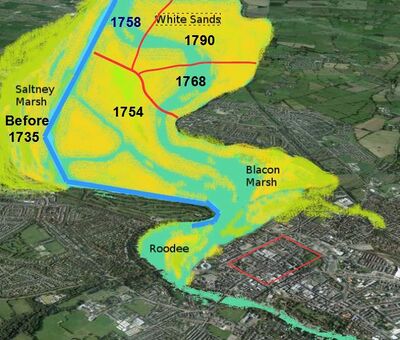
There are two sides to the estuary, a Welsh side and and English side, a side of boom and a side of bust. There is the ebb and flow of the river, of history and of economic cycles, mirrored in the narrow place the earth occupies between green-house and ice-house. We do not know what the future holds, whether the Dee will continue to silt so that sea becomes land, or that global warming will raise sea-levels such that land once more becomes sea. Over geological time the sun has brightened, warming our world, but on earth, the gradual locking up of carbon in coal, oil and limestone has removed "greenhouse gas" from our atmosphere and maintained a shaky equilibrium disturbed by the wobble of the planet's orbit and the occasional catastrophe. Fortunes have been made, and lives spent, bringing this buried carbon back to the surface - as coal, oil or gas. Above the river, coursing across the navigational stars, the neighbouring planets Venus and Mars tell something of different fates. Venus, Earth's near twin, yet a little closer to the sun, has fallen foul of a runaway green-house and broils in a sulphurous hell that would melt lead. Mars, just too far out, lies locked in an age of icy and rusty deserts.
The Old Port or Portpool
It has been suggested that during the Dark Ages the main harbour at Chester may have been above the present weir at The Groves. From Norman times an important anchorage developed to the south of Chester Castle and explains the location of the medieval Shipgate. As silting continued (and ships drew more draught) the harbour moved progressively downriver. The most upriver remains of docks, in Chester itself, can now be seen at New Crane Bank below the boardwalk installed in the 2000's. John McGahey's "View of Chester from a Balloon" shows the Old Port c.1855. The Old Port has been linked to the Groves by the Riverside Promenade Heritage Trail. Hemingway (Vol II, page 301) records the following as regards the port of Chester:
- That the Dee was navigable for vessels of great burden from the sea up to Chester in very ancient times is beyond all doubt and it is equally certain that early in the 14th century the navigation had been materially impeded by the shifting of the sands. The first notice we have of the latter circumstance is contained in letters patent of Richard II who releaseth to the citizens £73 10s 8d parcel of the £100 for the fee farm reserved by the charter of Edward I which the city was in arrears in which also is assigned as the reason of this indulgence the ruinous estate of the city and of the haven. Henry VI in confirming all the former charters of the city recites what great concourse in times past as well by strangers as others has been made with merchandise into this city by reason of the goodness of the port thereof and also what great trading for victuals into and out of Wales to the great profit of the city and then shows how the same port of Chester was lamentably decayed by reason of the abundance of sands which had choaked the creek and for these considerations released to the city £10 of the fee farm reserved by Edward I.
Chester was not only a port but a noted centre for ship building. In the "Magna Britannia" (1810) is written:
- There are now more ships built at Chester than at Liverpool, they being in great estimation among the merchants at that and other principal sea ports of England and Scotland as particularly well founded and in the mariner's phrase "sea-worthy".
The history of the canalisation of the Dee can be found on the page describing the history of Chester as a port. Heading downriver, the Dee makes a sharp turn south-west at Wilcox Point between the Canal and Boatyard and the eventual pouring into the Dee of Flookersbrook. Two further turns bring the Dee to its north-western course, arrow-straight down the "New Cut" towards Connah's Quay.
A Canalside Gallery: Around the Dee Branch basin
There is still something to seen of the Old Port besides the tidal basin. At New Crane Bank, the former warehouse, approximately 40 x 8m in plan, was originally built 1750s or 1760s, with the north end rebuilt in the 19thC after a fire; the nearby cottages are somewhat later than the former warehouse.
The "Dutch" lifting bridge, Watertower and "Ark"
Blacon Marsh and the Flood Plain
When the River Dee is in flood and there is an incoming tide and wind, there is a considerable risk of flooding in the Lower Reaches. The "Finchetts Gutter Flood Storage Reservoir" covers an area of land near the northern side of the Sealand Basin, on the site of the former Blacon Marsh. Finchetts Gutter is an extension of Flookersbrook from Stone Bridge to the River Dee. The flood plan is that excess water is diverted onto the flood plain where it can be stored until the level of the River Dee falls. The small white cottage (c1800) on the A548 (Sealand Road) is believed to originally been the site of, or even a part of, the "sluice house" which controlled the flow along the gutter. The flood defences also extend northwards from the river along the line of the canal.
There have been applications to build housing on parts of the flood plain. These have met with objections by local campaigners.
Saltney and Blacon Point
In 1872 John Marius Wilson's Imperial Gazetteer of England and Wales described Saltney as follows:
- "SALTNEY, a village and a township in Hawarden parish, Flint. The village stands on the river Dee, at the boundary with Cheshire, and on the Chester and Holyhead railway, at the junction of the Chester and Shrewsbury railway, 2 miles S W of Chester; is practically the port of Chester; underwent much enlargement, in recent years, in connexion with railway -works, iron-works, candle-works, manure-works, the opening of collieries, and the establishment of a corn mill and of a wire-rope manufactory; and has a post-office‡ under Chester, and a r. station. The township comprises 2,185acres. Real property, £7,517. Pop. in 1851, 854; in 1861, 1,325. Houses, 266. The manor belonged anciently to Basingwick abbey. Much of the land, till so late as 1778, was an open marsh. Henry II encamped here in 1157."
Saltney is part in Wales and part in England, as can be seen here the border runs straight through the middle of the town, past the now disused (and in fact completely traceless) station. The English-Welsh border runs down the middle of Boundary Lane in Saltney, the only urban street in England and Wales where this happens. This means that houses on the west side of the street are in the Flintshire County Council area and in the North Wales Police jurisdiction, while those on the east side are in the Cheshire West and Chester unitary authority area and in the Cheshire Police jurisdiction. Residents living on the west side fall within the Alyn and Deeside parliamentary constituency and those in the east are recorded in the City of Chester electoral register.
But Saltney is far older than the railway: the fringes of the great salt-marsh at Saltney were the traditional camping spot for armies heading for an invasion of Wales under Henry II (1157) and Edward I (1277). The name "Saltney" may hint at Viking origins in the form of "Island of Salt", which could refer to a settlement on a dry patch in a salt marsh. Even earlier, the Romans of Chester would have found an extra-mural settlement here, although the buildings seem to have been little more than rough stone huts. In Roman and earlier times the Dee estuary came this far inland, curving around the headland to the north known as "Blacon Point". The monks of Basingwerk:
- "..possessed the marsh of Saltney for pasturage, it having been granted by Robert, lord of Mold, who bestowed on them the like privilege in Hawarden, and also that of cutting rushes to thatch their buildings. The tract extended into Cheshire, and a stone near the east end marked the boundary in that county."
There was once a ford at Saltney, said to be reachable by a difficult path through the marshes between Blacon and Saltney and only usable at low-water. Parish records testify to the many tragedies on the Saltney Marshes, deaths by drowning or murder or other causes, that it is little wonder travelers between Flintshire and Cheshire preferred the more circuitous but safer Kinnerton and Balderton Bridge route. The best known river-crossing hereabouts was at Saltney Ferry, established by the Manifold family c.1740 and run by the same family until it's closure in 1968. Mike Griffith's book (see list below) contains a wealth of information on the last father and son to operate this ferry, and the ferry steps can still be seen besides the modern footbridge. In 1768 Sir John Glynne's Canal - used for the transportation of coal from mines in Flintshire into Chester - was cut for the two miles between Bretton and Saltney (it was abandoned in 1775 after only 10 years use and eventually disappeared with the Saltney Marsh Enclosure Act of 1778). Richard Willett's "Memoir of Hawarden parish, Flintshire" gives an account of the early chemical industry in Saltney:
- In the year 1781 Mr Tharp a button manufacturer in Chester purchased a small allotment upon the lately enclosed Saltney Marsh and near to Big Mancott lane end where he erected "the Chemistry". To this place he sent down his refuse horn and bones from which he extracted Glauber's salts and sal ammoniac and ground down the calcined residuum into ivory black.
In the 1840's "Railway Mania" became the latest speculative craze. It followed a familiar pattern. The price of railway shares increased and money was poured in by speculators, until the inevitable collapse. In 1846, no fewer than 272 Acts of Parliament were passed, setting up new railway companies, and the proposed routes totalled 9,500 miles (15,300 km) around a third of which were never built. Many companies collapsed due to poor financial planning, or turned out to be a fraudulent schemes. The line in Lewis Carroll's The Hunting of the Snark: "They threatened its life with a railway share", is a reference to the Railway Mania and those who lost money investing in it.
The new industrial zone at Saltney was related directly to the arrival of the railway. It developed rapidly into the city's most vibrant industrial area in the mid 19th century and made a large contribution to diversifying Chester's economic base. The trigger for its growth was the opening by the Shrewsbury and Chester Railway in 1846 of a wharf on the Dee adjacent to the railway junction with the Chester and Holyhead line. Industrial development began in 1847 with the establishment of Henry Wood & Co.'s anchor, chain, and general engineering works. The firm had been founded in Stourbridge (Worcs.) in 1786. The Saltney works, on Boundary Lane, had both a railway siding and access to Saltney wharf. A number of other firms followed Wood's to Saltney. Lloyd's Cambrian Chain and Anchor Testing Co., was set up in 1866. By 1870 three oil refineries were in operation, of which the largest was the Flintshire Oil & Cannel Co. at St. David's Oil Works. The others were E. S. Rogers & Co.'s British Oil Works and the Dee Mineral Oil Co., set up in 1869. They mostly processed crude oil produced from cannel coal in the Flintshire coalfield, and were part of an industry which boomed locally from 1858 to the 1880s. The "Sal Ammonionic" (sic) works was operating in Saltney as early as 1843, and in 1856 Proctor and Ryland moved there from Birmingham and opened a bone manure works on the riverside.
The railway also brought industry to Saltney on its own account. The Shrewsbury and Chester Railway established its locomotive and carriage works there in 1847, and after the company was acquired by the Great Western in 1854, the latter moved its standard-gauge carriage and wagon works from Wolverhampton to Saltney. The Victoria Waggon Co. was also operating at Saltney by 1860, though it had closed by 1870. Furthermore the goods yards at Mold Junction became the main concentration and distribution point for roofing slates from the north Wales quarries. Saltney's population grew from 554 in 1841 to 1,901 in 1871 as a result of the area's industrial development. It had reached a population of 4,769 at the 2001 Census.
Shipbuilding at Saltney continued into the 1920's. The Steamship “R.H. Carr” was built at Saltney, Flintshire in the Shipyard of Messrs. J. Crichton and Co. Ltd. Established in 1913 by James Crichton (1885-1932) on the banks of the River Dee. The company built many kinds of vessel, including tugs, barges, ferries, lightships and launches. The Saltney Yard closed in 1935 due to economic problems and overcapacity in shipyards. Launched on the Saturday 30th April 1927 the 308 ton RH Carr should have been in service the previous September but had, according to a contemporary report in the Cheshire Observer been delayed “owing to the disastrous strikes of last year, which completely held up British steel supplies and the vessel had to be built of all-British material”.
Saltney's oil boom has ended now and most of the original industries are long-gone. It's docklands have become home to "marginal" industries: car-breakers, scrapyards, useful one-man garages where a skilled welder works alone. Decaying wharfs, the odd pill-box decorated with fading graffiti leaving open the puzzle of just what it was guarding, inlets choked with dark oily mud and the occasional wreck of someone's nautical hope. The people are friendly enough, and keen to talk to the passing historian, but there is the feeling here that the river passes by, trapped in it's straight cut, and takes little part in local life.
Sources and links
- Saltney on Wikipedia;
- Saltney Local History Group;
- R. H. Carr a Saltney-built ship whose remains lie at Skull Point on the Cuyuni River, Guyana. A wonderful story and a very well put-together site: well worth a look!;
Shotwick
Shotwick Castle originally stood on the east bank of the River Dee and was accessible to shipping as well as being in vicinity of a ford across the river. A castle was established at Shotwick around 1093 by Hugh of Avranches, the Norman Earl of Chester. This early fortification was a simple earth and timber motte-and-bailey structure, sited on top of a steep escarpment overlooking the river, and protected on its north and south sides by water features that were filled at high tide. The motte was also surrounded by a flooded ditch and, judging by the shape of the mound, may have had a jetty on its western side.
Due to its location on a communications artery into North Wales, Shotwick became a frontier fortress. On his Welsh campaigns of 1156 and 1165, Henry II used the adjacent Shotwick to Flint ford as his access into Wales. Accordingly, at some point during the twelfth or early thirteenth centuries, the castle was rebuilt in stone. A rectangular stone keep, sited on top of the motte, was probably the first structure rebuilt but this was followed by a substantial pentagon shaped curtain wall that originally stood over 15 metres tall and was augmented by numerous towers. Shotwick is associated with the legend of the Lady Cave at Hilbre Island.
Shotwick was acquired by the Wilbraham family in 1627 but by this time the castle was ruinous and stonework was being robbed-out to support local building projects. The diversion of the River Dee in 1737 led to the site becoming land-locked and hastened its decline - within a few decades all masonry had been removed. The castle site was purchased by Cheshire County Council in 1930.
There was a church at Shotwick at the time of the Domesday survey and it was in the possession of the secular canons of St. Werburgh in Chester. It passed to the Benedictine monks who took over the abbey in 1093. Although the church was rebuilt in the 14th century the original Norman arch to the entrance remains, now hidden from the exterior by the porch. The tower is Perpendicular in style, and dates from around 1500. The church underwent further restoration in the middle of the 19th century with the replacement of the former single span roof by a double roof covering the nave and aisle. The main part of the structure dates from the late 14th century with the tower, built in the Perpendicular style, dating from about 1500. The church was restored again in the 1970s.
Sources and links
Hawarden and Sealand
The river passes on, tamed and bound by it's artificial banks, straight as a knife's edge. There was shipbuilding all down this reach once. Chester ship Royal Charter (Sandycroft Ironworks, 1855) - was built here, and was so large that she had to be slid into the river sideways. She was a new type of ship, a 2719 ton, steel-hulled steam clipper, built in the same way as a clipper ship but with engines for use when becalmed. A fast ship, she was able to make passage to Australia in under 60 days. Royal Charter was wrecked (October 26 1859) in a "force-12" hurricane off Anglesey. Returning from Melbourne with 388 passengers, a crew of 112, and a cargo of gold valued at £300,000, her passengers included gold miners who had struck it rich in Australia and were carrying large sums of gold upon them. Many were said to have drowned weighed down by the belts of gold they wore. Charles Dickens (in his "Uncommercial Traveller") gives a vivid illustration of the force of the gale:
- "So tremendous had the force of the sea been when it broke the ship, that it had beaten one great ingot of gold, deep into a strong and heavy piece of her solid iron-work: in which also several loose sovereigns that the ingot had swept in before it, had been found, as firmly embedded as though the iron had been liquid when they were forced there."
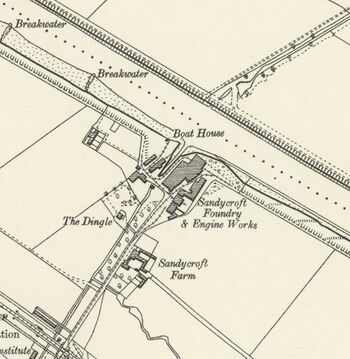
A considerable quantity of gold was said to have been thrown onto the coast near Moelfre, with some families becoming rich overnight. Brunel's later-launched steamship the Great Eastern, then standing off Holyhead harbour on sea trials, survived the same gale, now known as the "Royal Charter Storm". Brunel (who also invented the bar) had died a few weeks earlier, worn out by construction of the ship and finished-off by news of a boiler explosion. At Eastern's breaking-up (at Rock Ferry, in 1889–1890) Liverpool Football Club purchased her top mast as a flag pole - it still stands there today, on the corner of the Kop and Centenary Stand. The storm inspired Robert FitzRoy (captain of HMS Beagle during Charles Darwin's famous voyage) to develop charts to allow predictions to be made, which he called "forecasting the weather".
A modern day Leviathan of the skies is often seen hereabouts in the form of the Airbus Beluga, a version of the standard A300-600 wide-body airliner modified to carry aircraft parts and over-sized or awkward cargo. It is a frequent visitor to the aircraft factory at Broughton. Airbus wings produced in Broughton are flown out in Belugas with the exception of the large A380 wings which are transported by barge along the river Dee to Mostyn docks. The transport barge is called the the Afon Dyfwydwy (River Dee) and made it's first trip in April 2004 after extensive surveys. The tide has flood coming very quickly and ebb taking longer than expected. This means that strict vessel-movement planning is needed to ensure sufficient water to move against the tidal stream and clear the bridges. During these surveys is was discovered that the navigable channel sometimes moves 20 to 30 metres between tides.
RAF Sealand was originally a civilian airfield founded in 1917 when a local mechanic and entrepreneur Tom Dutton began a private flying school on fields rented from the John Summers Steelworks. It was taken over by the military in 1916 for training (Tom never did get it back). It was from these hangars that the young pilots learned the skills to take on the might of the Luftwaffe in Sopwith Camels over the trenches of Northern France in the Great War and a generation later in Spitfires and Hurricanes to repel the bombing raids of the Blitz. No 30 Maintenance unit was formed there in 1939. In 1951 the base was taken over by the United States Air Force, and handed back to the RAF in 1957. As a result of defence cuts announced in 2004, RAF Sealand was closed in April 2006.
There is a tradition that the church at Hawarden was established by St Deiniol, the founder of the monastery at Bangor-on-Dee in the mid-6th century, and in the absence of any evidence to the contrary, this date must be accepted as marking the origins of Hawarden. A church is recorded in the manor of Hawarden in Domesday Book (1086), and it is reasonable to equate this with St Deiniol's.
Hawarden contains two castles; one rebuilt by Edward I, the other once the home of William Gladstone, four times British Prime Minister. The defensive works at old Hawarden Castle appear to date back in part to the Iron Age. At Easter 1282, Dafydd ap Gruffudd attacked Hawarden Castle, starting the last major Welsh conflict with the English, as a consequence of which Welsh independence was lost. Edward I personally designed a special punishment for Dafydd and had him hanged, drawn, and quartered in Shrewsbury in October 1283. The castle was again captured in 1294 during the revolt of Madog ap Llywelyn. During the Civil War, it was at first garrisoned by Royalist troops who maintained control except for a brief time in 1643, and then until March 1646, when the castle was surrendered to Parliamentary forces. Afterwards the castle was slighted on the orders of Cromwell. Its ruins are on the New Hawarden Castle estate and are open to the public on some Sundays, typically the second and fourth Sundays in summertime.
Sealand station was located on the Great Central Railway's (GCR) Chester Northgate to Hawarden Bridge line which opened on 31st March 1890. The line was part of a through route to Wrexham Central and, from 16th March 1896, there was also a line from Hawarden Bridge to Bidston on the Wirral; this was directly accessible from Sealand as there was an east-to-north connecting line a short distance west of the station. The Reshaping of Britain's Railways (Beeching) report of 1963 recommended the withdrawal of all services from Sealand. However a year later the station still had fourteen weekday services to Wrexham Central, twelve to Shotton High Level, six to New Brighton and thirty-two to Chester Northgate Station. Goods facilities were withdrawn on 5th April 1965 although a private siding remained in use. Despite local protest the services between Chester Northgate and New Brighton, and between Chester Northgate and Wrexham, were withdrawn on 9th September 1968, and Sealand Station closed completely. It appears to have been demolished shortly after closure. The line continued in use for goods traffic between Hawarden Bridge Junction and Mickle Trafford until 20th April 1984. On 31st August 1986 the line reopened, again only for goods services. It was reopened as single-track, and at Blacon only the former Chester direction line was retained. The reopening was short-lived, and the line closed again in June 1992. Since the line between Chester and Dee Marsh closed, the track has been lifted and the route is now a cycle path, forming part of Route 5 of the National Cycle Network.
Sources and links
- Hawarden on Wikipedia;
- Hawarden Castle at Castlewales;
- Hawarden: a history;
- Listed buildings in Hawarden;
- Sealand on Wikipedia;
- Sealand Comunity Council - local history page;
- Hawarden - Clwyd Powys Archaeological Trust;
Queensferry
Queensferry was originally named Lower Ferry (Welsh: Y Fferi Isaf). It changed its name to Kingsferry on the coronation of King George IV of the United Kingdom in 1820.
The Dee fords downstream from Chester were destroyed by the cutting of a new river channel, and were replaced by two ferries. Under an Act of 1744 the River Dee Company was to supply the boats and maintain the roads leading to them. The Higher Ferry was at Saltney. The lower ferry was renamed Queen's Ferry (later giving rise to the place name Queensferry) after Victoria became queen in 1837. Both ferries were eventually superseded. In 1894, the Queensferry Bridge Act authorised the construction of a toll bridge, a retractable timber structure completed in 1897 to a design by T.W. Barber: The Victoria Jubilee toll bridge, to replace the lower ferry. Now, only the abutments of that bridge remain. In 1926 it was rebuilt and made free of toll and in 1962 it was supplemented by the Queensferry bypass bridge. The 1926 replacement bridge was designed by Mott Hay and Anderson, and built by Sir William Arrol and Co. Ltd, for £83,051. It is a double-leaf bascule bridge built to the Scherzer "rolling lift" design, although it has been fixed at midspan and no longer opens. Boats are still able to pass below, including barges carrying Airbus wings. The central span is 40.8m, the two side spans each 40.5m, and the deck is approximately 10m wide. In Scherzer's design, the bascules roll back onto curved steel girders, rocking-horse style. Ballast chambers at the top of the curved girders balance the weight of the deck and reduce the power required for operation.
When the Manchester, Sheffield and Lincolnshire Railway Company constructed the line over the River Dee near Queensferry, between 1887 and 1889, a swing opening mechanism was incorporated to allow vessels to access the industrial areas, and Chester, further upstream. The 752t, 287ft span was the largest (by 36ft) of its kind in Britain at the time. The total cost of the bridge was £71,000. Although in its early days of operation it was necessary to open the Hawarden Swing Bridge about 11 times a week, river traffic fell to such a degree that in 1971 the swing mechanism was decommissioned and the bridge closed. It is now welded shut.
Sources and links
- Queensferry on Wikipedia;
- The "Blue Bridge" aka Jubilee Bridge, aka Queensferry Bridge;
- Queensferry Bridge at the "Happy Pontist";
- Bascule Bridge, Queensferry at British Listed Buildings;
- Hawarden Bridge;
Connah's Quay and Shotton
Just before Connah's Quay the Wepre Brook flows into the Dee. A short diversion up this watercourse leads to Wepre Park, an ancient woodland valley that itself leads to Ewloe castle. The valley contains a peculiar pet cemetery as well as a stand of giant redwoods. In its native Sierra Nevada the giant redwood (Sequoiadendron giganteum, also known as Wellingtonia) reaches a height of 80 metres and can live for 3000 years. Giant redwoods weighing 2000 tonnes are not unknown. This deep-rooting evergreen with its thick spongy red-brown bark, has been planted in Britain since 1853.
Where the Wepre Park Visitor Centre stands today has been the site of at least two other buildings in the past. There was probably a Saxon dwelling here as long ago as the 7th century, a good 300 years before the Domesday Book of 1068AD talks of a “William” living on the estate, then owned by St. Werburgh's Abbey of Chester. During the Civil War of 1645, Edward Morgan, a Royalist, is recorded as staying at the older hall. He is probably the same Captain Morgan that commanded a battery of artillery (Morgan's Mount) during the siege of Chester. His remains were found in an unmarked grave at the edge of the marsh near Llanasa, where he was probably murdered. The classic Georgian Wepre Hall, was built in 1788 by Edward Jones after demolishing the Fitzherberts' ancient manor house. Edward was just 41, but had become a rich man after lead was found on his land near Holywell. Unfortunately the house was demolished in the 1960's, after being acquired by the local council.
Further up the Wepre valley is Ewloe Castle. In some versions of the long conflict between the English and the Welsh, the Welsh are portrayed as technologically inferior, however Ewloe is a native Welsh castle rather than an English one and has many of the distinctive features of Welsh Castles. These include the innovative D-shaped tower, which has the advantage of a rounded end with a good field of fire and no corners to bombard or undermine, as well as a square end which provides more living space. Welsh castles also tend to be built with the local topography in mind rather than domination of the local population, and they often make use of hilltops and crags to improve their defensiveness. Ewloe is sometime attributed to Llewelyn ap Gruffydd (1223-1282), but it was possibly built around 1150 by Owain Gwynedd, and converted to stone in about 1210 by Llywelyn the Great. Actually, it seems a rubbish place to build a castle meant as a military outpost. Even by clambering onto the very highest bit of the ruins you cannot see through the surrounding woods or out of the valley, so the English could sneak up on it with a siege-train to the valley top and bombard the hell out of it. Of course, the Welsh might have just been making a statement about their technology being as good as that of the English by building a castle on their doorstep, or they might have just wanted a place to hunt and fish.
The only way that anyone could run into trouble trying to besiege this place would be if they were foolish enough to bring an army up the narrow river valley. Whatever the intent, it is said that in 1157 a great battle took place between 3000 Welshmen led by Owain Gwynedd and the 30000 troops of Henry II. The Welsh had sent spies into the drinking dens of Chester to fathom the English plans and (discovering that the English were going to bring an army up the narrow river valley) set the obvious trap. During the ambush in which Henry was almost killed by Owain Gwynedd's sons, the English King's forces suffered a crushing defeat. The site of the battle is today marked by a plaque by the bridge (Pont Aber) shown in the photograph. The bridge used to be further upriver (Pont Saeson) and was moved to the current location around 1800. Despite the Norman-English rout, which was compounded by the defeat of the Naval detachment at Anglesey, Henry's superior numbers enabled him to continue onto Rhuddlan prompting Owain to make peace with the King. The heavy cost to his vast army was a humiliation for Henry II and one that seemingly left its mark - he would attempt to invade Wales again in 1165 but crucially chose not to follow the same coastal path that he did in 1157. Instead he advanced over the Berwyn Hills where he was defeated by the weather.
Connah's Quay (Cei Connah in Welsh) is the largest town in Flintshire and the derivation of its name has many interpretations. One view is that it came from the name of the landlord of The Old Quay House by the docks, another is that Connah was the owner of a chandlery store. A further version is that Mary Connah owned the docks and when people crossed the Dee they asked to be taken to Connah's Quay. By the late 1950s, the port had virtually ceased trading and the railway was in terminal decline. The two docks had by then long silted up, imprisoning the rotting hulk of an old wooden ship, the Bollam. This old vessel was believed to have taken part in rescuing the defeated British Expeditionary Force from Dunkirk. The closure of the port brought an end of the fishing industry. Fishermen would row out across the river in an arc, paying out a long net over the stern of the boat as they went: known as seine fishing. They then returned to shore and hauled in the net. Mostly they caught fluke, which would then be sold from barrows pushed around the housing estates.
Shotton is a Welsh town with an Anglo-Saxon name. If you are going to visit on a Sunday by train, consult the timetable as stopping trains are non-existent in the middle of the day. John Summers, whose name has become synonymous with Shotton, never saw the town or even the Dee marshes where the ironworks that bore his name was built. Born in Bolton in 1822, aged 20 he moved to Dukinfield, thirty miles away, and began working as a clogger. He married in 1848 and had eleven children. In 1851 he visited the Great Exhibition in London, bought a nail making machine, and commenced making nails with which to fasten the iron strips on to the soles of clogs. His business expanded rapidly and in 1852 he moved into Sandy Bank Iron Forge, at Stalybridge, where he concentrated on the production of clog irons and nails. He purchased nearby land and built a new ironworks, the "Globe Works," which within a few years was making an annual profit of £2000. John Summers died on 10th April 1876, at the age of 54. Three of his sons, James, John and Alfred, carried on the business, and they were joined by another brother, Henry Hall Summers in 1869. Henry visited Shotton in 1894 looking for land upon which to build a new factory for sheet rolling mills: room for expansion at the Globe Works having been exhausted. The firm opened the Hawarden Bridge Steelworks at Shotton in 1896. In 1898 the firm became a Private Limited Company and in 1908, on completion of new offices, the headquarters were transferred to Shotton.
By 1909 the company was the largest manufacturer of galvanized steel in the country, and probably the largest manufacturer of steel nail strips and sheets. By 1910 there were 3,000 employed at the steelworks and the Summers brothers allowed two breweries to be built on site making non alcoholic drinks - because they had learned that two men were being paid 30 shillings a week to bring beer into the works for men working in the hot mills. In 1919 the Wolverhampton Corrugated Iron Company at Ellesmere Port was taken over and steel from Shotton was caried to Ellesmere Port on the River Dee and the Wirral Line of the Shropshire Union Canal via Chester. John Summers & Sons also bought the Castle Fire Brick company in Buckley and the next year took over the Shelton Iron, Steel & Coal Co, Stoke-on-Trent. This company was Shotton's supplier of pig iron, a very scarce item at the time and this acquisition meant that the company had become very largely self-contained and self-sufficient. John Summers & Sons Ltd was nationalised in 1951, becoming part of the Iron and Steel Corporation of Great Britain. By the 1960's Shotton Steelworks was so big that articulated buses - with benches for seats - were used to ferry staff around the works which was once said to be up to eight miles wide. There was also a fleet of cars with registration numbers from 1 to 100. And at one time there were 30-plus steam engines working on-site which, between 1953-67, hauled 17m tonnes of ore to the works before diesel locos took over. The so-called heavy end iron and steel making operations were closed in March 1980 with the loss of 6,500 jobs.
The new highway crossing of the River Dee incorporates a major cable-stayed bridge with a single A-frame tower and a main span of 200 m. Support for the bridge is provided by "barrettes" that pass through 30 m of superficial Quaternary formations into bedrock strata of the Carboniferous Bettisfield Formation. Lithology of the bedrock stratigraphic sequence varies greatly over short distances and required a flexible response for foundation design. Below the north tower leg, barrettes were socketed some 7 m into massive sandstone that provided relatively good foundation bearing conditions. However, only 50 m away, below the south tower leg, each barrette required individual design to accommodate much weaker and diverse lithologies including siltstone, mudstone, coal, seatearth and disturbed beds. Here, certain barrettes extend as much as 30 m into the mixed coal measures strata.
Sources and links
- Keith Atkinson's Shotton History;
- Connah's Quay on Wikipedia;
- Shotton on Wikipedia;
- History of Shotton - local history page;
- Shotton Steelworks at Grace's Guide;
- Ewloe Castle at Cadw;
- Ewloe Castle at Castlewales;
- Battle of Ewloe/Coleshill;
- History of Wepre Park;
- the Flintshire Bridge - the 1998 cable-stayed bridge;
- walk and cycle route along the River Dee from Chester to Connah's Quay;
- Flood risks on the River Dee
Neston and Parkgate
The western edge of Wirral lies in the path of moist, south-westerly winds, but it is also in the lee of the North Wales mountains. This reduces the amount of annual rainfall it receives to about 75cm (30 inches) - forty or more inches being typical elsewhere (see Weather). Although wetter than the east coast of England, it is still one of the driest districts on the west coast. The area also experiences fewer and less severe frosts than the Cheshire Plain because of its proximity to the coast. These effects add up to the "Wirral Micro-climate", a possible reason why Roman Chester was sited where it was.
In 1541 the Chester corporation adopted a plan to build a new harbour some 10 miles down the Dee estuary at Lightfoot's Pool in Little Neston, perched on a sandstone outcrop jutting out to sea, and Henry VIII ordered 200 trees to be delivered to the mayor for that purpose. The name "Neston" is of Viking origin, deriving from the Old Norse Nes-tún, meaning 'farmstead at/near the promontory'. In 1548, in response to a petition from the city for aid with the work, the orders were repeated and augmented by a grant of £40 for seven years. Despite a further appeal for a royal grant in 1551, the city was forced to raise funds locally; between 1555 and 1560 voluntary rates and special assessments were imposed on the guilds, parishes, and citizens, and special payments were exacted from members of the corporation. Work was evidently well under way by 1565, when a salaried overseer was appointed. In 1566, however, the "great pier of stone" which formed the main feature of the haven was largely overthrown in a gale. To repair the damage a further special assessment was made in 1568 on the citizens and the guilds of Chester, and councilmen were ordered to oversee the work at their own cost. The New Haven, otherwise known as Neston Quay or New Quay, eventually comprised an anchorage protected by a stone pier. The project, which was probably never completed, remained a constant burden on Chester's finances throughout the later 16th century, despite appeals to the Crown for grants out of customs revenue in 1576 and 1589. Its repair was aided by the Ironmongers' company in 1571, and was the subject of further orders by the Assembly in 1576, 1587, and 1598. The city's last recorded expenditure upon it was in 1604.
The port shifted to Parkgate with silting of the River Dee. Neston's fortunes were revived in the 18th Century, when coal was discovered (the only coal in the west of Cheshire). In 1759 John Stanley opened the Denhall (Ness) Colliery near what was later to becom Denhall Quay. Stanley built Denhall Quay in 1781 and coal was shipped to north Wales and to Ireland. The colliery had workings reaching under the River Dee and two underground canals 55 and 86 metres below sea level. A second colliery opened in 1819 no more than half a mile from Denhall. This was Little Neston Colliery owned by the Cottingham family it lasted till 1849 and in the years till it closed there were a series of incidents between the rival companies. Two court cases were brought against John Stanley at Chester Court, the first when a canal tunnel was blocked reportedly after Stanley's men were seen to bring up equipment, boats and horses, through No 6 pit. Tall boards were erected on the surface to prevent Cottingham from seeing what was going on whilst Stanley's men also hid their faces. Shortly after explosions were heard and Cottingham found that his tunnel leading from Pit 21 to the canal had been blown up. In the second Cottingham sued Stanley for trespass and wilful damage to his mine for the sum of £10,000, based on lost sales and Stanley's malicious intent. In court Robert Johnson, Stanleys agent; did not deny that Stanleys men had destroyed the tunnel , but justified the damage done as being part of a scheme to manage the ventilation of Denhall Colliery and to prevent Cottingham's men from destroying the canal. The judge ruled that there was no malevolence involved and Stanley acted on his agents best intended advice. The jury found in favour of Cottingham. These early colliery's failed due to the siling of the Dee. The later Wirral Colliery company, with a railway connection. was a big employer, providing work for nearly 200 people in 1896.
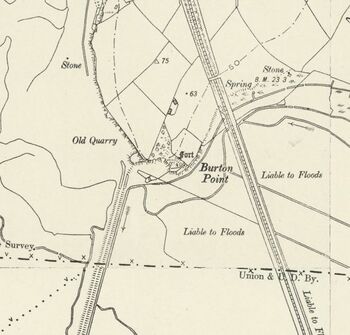
Neston was the birthplace of one of Nelson's mistress, Emma Hamilton, who was born (1765) to a humble family in Neston before "working her way into polite society". Born Emy Lyon in Ness near Neston, the daughter of a blacksmith, Henry Lyon, who died when she was two months old, she was brought up by her mother, formerly Mary Kidd, at Hawarden, with no formal education. She later changed her name to Emma Hart. Progressing through working Drury Lane as a prostitute, she gained employ in a local tavern/brothel and became an early strip-tease artiste. Emma next worked as a model and dancer at the "Goddess of Health" (also known as the "Temple of Health") for James Graham, a Scottish "quack" doctor. The establishment's greatest attraction was a bed through which electricity was passed, giving paying patrons mild shocks. She was still only fifteen. Passed on as mistress to various men, she was eventually (1786) packed off to Naples in return for settling debts between Charles Francis Greville and his uncle Sir William Hamilton, an antiquarian, archaeologist and vulcanologist and also British envoy to Naples. They married in 1791: he was 60; she was 26. As wife of the British Envoy, Emma first met Nelson in 1793 but their famous affair did not begin until he returned to Naples five years later, a living legend, after his victory at the Battle of the Nile in Aboukir. Not yet 40, Nelson's adventures had prematurely aged him: he had lost an arm, most of his teeth, and was afflicted by coughing spells. Emma, now in her early thirties nursed him at her aged husband's country villa and the affair started. Emma seems to have been involved in persuading Nelson to allow the court marshal of Francesco Caracciolo who was subsequently hanged. Nelson was mortally wounded during the Battle of Trafalgar (1805) and brought back to England, pickled in brandy. Emma turned to drink and died (1815) in poverty, of amoebic dysentery.
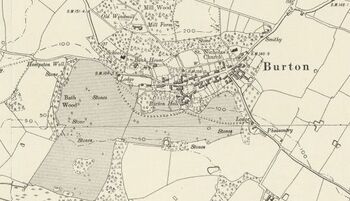
Parkgate grew from the early 17th Century, and by 1686 had become a major passenger port for Ireland. Handel stayed in Parkgate before sailing to Dublin in April 1742 for the first performance of Messiah. He had finished Messiah in the summer of 1741 and at most he could only have added minor touches to the work in Parkgate. The main channel of the River Dee passed only 50 yards from the sea front. Even though the shifting sands of Dee had brought favour to Parkgate, it was never regarded as a good anchorage. The Collector of Customs at Chester had advised the Committee for the Affairs of Ireland in 1689 that only those ships which could safely lie aground should use Parkgate, but that larger ships or those not built to lie aground, should use Hoylake. The year before the Customs had established a boat station at Parkgate, as a means of keeping an eye on the Dee shipping, and once there, insisted on retaining Parkgate as a "legal quay" where goods could be examined, despite the protests of the City Assembly in Chester which declared in 1707 that Parkgate ‘is now become a very dangerous place for ships to lye in for lading and unloading of goods’. When the Bill for Chester’s New Cut, which canalised the Dee, was being discussed before Parliament in 1732, Captain Stephens deposed that ‘Parkgate is a very bad and dangerous harbour for ships to lie at, they being very much exposed to the winds, and their bottoms are often damaged by running on ground’. Nor did the anchorage improve later in the century. Admiralty sailing instructions for Parkgate in 1794 advised, ‘Vessels must lie aground on the beach below the houses, because the strength of the stream would make a vessel drag her anchor’. With the opening of the New Cut, both the river channel - and passenger trade - dried up.
Ness Gardens was founded by Liverpool cotton merchant Arthur Kilpin Bulley who began to create a garden in 1898, part of which he opened to local residents. Bulley died in 1942, and in 1948 his daughter Lois presented the Gardens to the University of Liverpool with an endowment of £75,000. The only stipulation was that they be kept as a botanic gardens as a practical and fitting tribute to the memory of her father. Bulley's policy of opening a specified area of ornamental ground to the public was also to be continued. When Arthur Bulley first bought the site, it was open and windswept. However, the Gardens are now quite sheltered by Bulley's plantings of Lombardy Poplars, Holm Oaks, Scots and Black Pines. More recently planted Leyland Cypress, Italian Alder and Common Holly on the perimeter, and the growth of trees and shrubs within the Gardens, have created some very sheltered areas. The terraces in particular, located on a south-facing slope, sit in a sun trap where plants grow that would not survive in other parts of the Gardens.
Sources and links
- Neston on Wikipedia;
- Neston collieries;
- Neston Coal Mining;
- Ness Colliery Trail;
- Neston - local history page;
- Ness Gardens official website;
- NestonPast - local history site;
- Burton Point Hill-fort on the Megalithic Portal;
- Parkgate on Wikipedia;
- Place, G. W., (1983). Parkgate as a port. Journal of the Chester Archaeological Society 66. Vol 66, pp. 47-55.
Fflint
- "The Borough of Flint contains 2860 inhabitants. Many are employed in the coal mines; others in the alkali works, and in smelting lead; and at present vast numbers find work upon the Chester and Holyhead Railway, which passes through the town. It is stated that children 8 or 9 years of age are sent to work in the coal pits, and at an early age are able to earn from 3s to 9s per week. The character of the inhabitants is degraded in respect of turbulence, intemperance and debauchery. The prevailing vice of the neighbourhood is drunkenness, which is rendered more flagrant and pernicious from the prevalence of the old Welsh custom of keeping merry nights. A week previous to my visit a murder had been committed by a party (as was supposed) who had been thus engaged in revelry. The clergyman informed me that fornication also is common in the town and neighbourhood; but that in Flintshire, as in England, it assumes the form of promiscuous debauchery, and is not a recognized and systematic institution as in other counties of North Wales. The female population are ignorant of economy and of all kinds of domestic industry in consequence of which, and of the general improvidence and intemperance of the men, the social condition of Flint is almost as degraded as at Rhosllanerchrugog (Ruabon). The streets of the town are filthy; the houses are wretchedly built, and in worse repair; and the people are squalid and in rags. I visited several cottages in the town. A small house, 10 or 12 feet square, with a chamber above, accommodates on an average 2 parents, 6 children, and 6 lodgers. The floors are of earth, and in wretched condition. There is no room for furniture, and the interiors are filthy and unwholesome. I saw other cottages of 9 feet square, with no other room adjoining. These generally contain a husband and wife, with infants and a lodger. I visited a parish almshouse of these dimensions containing 9 people--a father, mother, and 7 children. There was one bed for the parents and another for the 7 children, both placed in the only room which the house contained. The eldest boy was 16 years old, the eldest girl 15. English is as much spoken in the town as Welsh; nearly all the inhabitants understood English." - Report of the Commissioners of Enquiry into the State of Education in Wales of 1847.

During the early post-glacial period sea level lay about 35 metres below its present level. The area now occupied by the town of Fflint would have been on the edge of a deep and wide river valley, well inland, on a low coastal plain that stretched from the north Wales coast across Liverpool Bay to the Isle of Man and the Lake District. A rapid rise in sea level took place between about 10,000 and 3,000 BC due to the melting of the glaciers; the consequent flooding of the great coastal plain created what is now Liverpool Bay and, in the wide river valley, the Dee estuary. The earliest evidence of activity that has so far come to light in the Flint area belongs to the Early Bronze Age, in the period between about 2,000–1,500 BC, based on the chance discovery of a flat bronze axe in the Pentre Ffwrndan area to the east of the town centre in the 18th century.
Discoveries which have been made in the area in the face of industrial and housing developments from the 1840s up to the present day point to the existence of a well-established Roman industrial settlement occupying an area of 3 hectares or more to either side of Chester Road (A 458) in the Pentre Bridge area, between St David’s Church and The Yacht public house (formerly The Ship). Finds include traces of numerous furnaces, stone and probably timber strip buildings as well as a number of human burials. Some of the industrial remains were found to be in poor state of preservation no doubt due to the later reworking mentioned by Pennant. The settlement was active for a period of at least two centuries, from the mid 80s to the middle of the 3rd century AD. Excavations opposite Pentre Farm in the late 1970s and early 1980s brought to light a high-status building complex belonging to the period between the earlier 2nd century and the mid 3rd century. Built initially of timber and subsequently of stone parts of the complex extend below the Chester Road, it included a small bathhouse, and had rooms decorated with painted wall-plaster. The presence of stamped tiles of the Twentieth Legion, which replaced the Second Legion at Chester in about AD 90, suggests that it may have been the residence and administrative complex of a resident official with responsibility for overseeing the metalworking industry. The complex was possibly laid out to lie parallel with the course of a Roman road which ran further to the south and it is perhaps no accident that this mansion was sited over 150 metres up-wind from the lead-processing works.
Little is so far known in detail about the history of the immediate environs of Flint in the period of almost 800 years between the later Roman period in the later 3rd and 4th centuries and the Norman Conquest in the later 11th century. Many of the major place-names which emerged during this period clearly indicate that the region formed a complex cultural and political border zone between the emerging Welsh and Anglo-Saxon kingdoms with some infiltration by sea-borne Viking settlers. The unstable and vulnerable political status of the region is hinted at in the name Perfeddwlad (‘the middle country’) by which it became known to the Welsh, a territory stretching for thirty miles along the north coast of Wales between the present-day Llandudno and Hawarden. The cantref or administrative area in which Flint fell was known to the Welsh as Tegeingl and to the Anglo-Saxons as Englefield, echoing the pre-Roman tribal name of the Deceangli.
- "In the Domesday Book a great part of the county of Flint of appears as a part of that of Chester under the name of Atis cross hundred. In the time of the Domesday Survey were only seven churches in the hundred and the division into parishes had not yet been made. Atis Cross from which the hundred took its name was near the town of Flint. The pedestal was remaining in the earlier days Mr Pennant" - The Penny Cyclopædia of the Society for the Diffusion of Useful Knowledge, Volume 10 (1838)
While happy with peaceful co-existence and trade, the Welsh never settled for dominance by their English neighbors. Welsh history was marked with a series of rebellions against their oppressive overlords. During the 13th century, Llywelyn ab Iorwerth (the Great) and Llywelyn ap Gruffydd (the Last), sought to regain control of Wales from the English kings, Henry III and his son, Edward I. Despite being recognized by King Henry in the late 1260's with the title of "Prince of Wales", Llywelyn the Last intentionally defied courtly protocol and refused to swear allegiance to the new king at any time during the following four years. In 1275, Edward called Llywelyn to Chester Castle to pay homage and was refused. Compromise with the Welshman was futile. For Edward, perhaps the final provocation came in the form of Llywelyn's planned marriage to Eleanor, daughter of Simon de Montfort. By 1277 the short-tempered Edward had reached the limits of his patience, and, while invading Wales, initiated what was perhaps the greatest period of castle-building in Britain.
The name Fflint is most probably derived from Old English or Old French - flint was used for any hard stone or rock, and is possibly a reference to the low sandstone hillock now below the castle, which must have been one of the few landmarks jutting into the otherwise featureless salt marshes. The castle was constructed of sandstone brought over from the quarry of Ness on the Wirral by raft. Not only was work carried out on the new castle, but an entirely new town was also erected. Flint was publicised in Lancashire, Nottinghamshire and Worcestershire and English traders encouraged to settle, by being offered burgages of up to 1000 sq. yards in the town and 40 acres outside, free of tax for their lifetime. Despite these enticements growth was small, Flint did not expand beyond the old walls until the 19th century.
Sources and links
- Fflint on Wikipedia;
- "Flint Through The Ages" - very well written and researched local history page;
- History of Fflint - CPAT history page;
Bagillt and Holywell
- "Bagillt is a bustling place, and will continue so, as long as her smelting and coal works go on in their present prosperous state. Well conducted boats go from this place to Chester every day; with a favorable wind, these little barks make the 17 or 18 miles in little more than two hours." J. Poole, Gleanings of the histories of Holywell, Flint, St. Asaph and Rhuddlan, 1831.
The name Bagillt is probably derived from an early Mercian settlement, "Bacca's lea" (the lea belonging to Bacca's people). It was at the very western edge of Mercia; Offa's Dyke starts at the coast in nearby Prestatyn and Watt's Dyke passes through Bagillt. A Cymrycized "-illt" led to the current name.
The origins of the name Holywell are obvious. It takes its name from the St Winefride's Well, a holy well surrounded by a chapel. The spring has been known since at least the Roman period. It has been a site of Christian pilgrimage since about 660, dedicated to Saint Winefride, and according to legend is said to have risen where St Beuno restored his niece St Winifride to life after her head had been severed by Cardoc, a rejected suitor. St Beuno is a well-attested 7th-century figure, responsible for bringing Celtic monasticism to much of north Wales. The well is one of the "Seven Wonders of Wales" and the town bills itself as "The Lourdes of Wales". Many pilgrims from all over the world continue to visit Holywell and the Well. The well is one of the few locations mentioned by name in the anonymous medieval alliterative poem Sir Gawain and the Green Knight. Richard I visited the site in 1189 to pray for the success of his crusade, and Henry V was said by Adam of Usk to have travelled there on foot from Shrewsbury in 1416. The present remarkable and architecturally unique building, set into a hillside, dates from the late 15th century. It was probably built for Margaret Beaufort, Henry VII's mother, to replace an earlier structure, and is richly ornamented on the exterior with a frieze of animals, and the badges of Henry VII and Thomas Stanley (Margaret Beaufort's third husband); the quality of the workmanship suggests that royal masons may have been employed. A copious spring of clear water rises in a central basin in the shape of a truncated eight-pointed star, with steps in the front for access by the sick. The water flows away beneath the surrounding walkway into a more recent swimming pool. The basin is enclosed by a low wall from which columns rise to form part of an elaborately ornamented vault of unusually complex design, matching the form of the pool below. The outflow of the well powered the mills at Greenfield (see below) which made products used in the slave trade.
At different times throughout the 19th century, there were at least 11 known coal pits in Bagillt. Bettisfield was the largest and most important of these. Owned by the Bettisfield Colliery Co. Ltd. it was opened in 1872. From the Inspector of Mines list 1896, there were 538 men employed including 100 surface workers, producing House and Steam coal. The two Shafts sunk to a depth of 290 yards. One shaft was 17ft. diameter, and the other l0ft. 6in. By 1908 it was in the hands of the Bagillt Coal Co. Ltd. employing 641men. Bettisfield Colliery Ltd. were again the owners by 1918 and at this time the total workforce numbered 450. In 1923 a total workforce of 502 produced House and Steam coal from the One, Two and Three Yard seams and the Queen and Five feet seams. It closed around 1934.
Coal had been mined in Flintshire at least as early as the 13th century but mining made little headway until the time of the Tudors. By the time of the Civil Wars there was a brisk trade in coal between Flintshire and Ireland and Chester had become dependent on Flintshire coal. There is a record of coal reaching Chester by way of the River Dee as early as 1326. Coal Mining continued in a small way during the medieval period, mostly by means of bell pits. These were shallow shafts with short chambers off at the bottom. Lacking the necessary technology, miners found it easier to sink another adjacent shaft rather than extend the workings. Such old workings can be identified by lines of infilled shafts and spoil heaps. Coal was first worked in this way in Clwyd, in what was to develop into the North Wales Coalfield. Mining tools and techniques were still primitive at this time, with little advance since the Romans. The late 17th century saw the introduction of gunpowder and this revolutionized the industry. By hand drilling shot holes in the rock and filling them with gunpowder, a great deal more rock could be removed in a shift. It allowed workings to go deeper but this meant pumping out water. Early pumps were very primitive, mainly the rag and chain pump. The 18th century saw improved technology, especially in the field of pumping. In 1714, the first steam engine in Wales was erected at Hawarden for pumping and others soon followed to allow workings to go deeper than ever before. Up to then, shaft haulage had been by hand windlass or horse gin but deeper shafts made this impractical. As a result, larger mines used steam engines for winding and this allowed a greater amount of ore to be removed.
Dee Bank Quay is the outfall from the Milwr Tunnel and is a remarkable industrial relic near Bagiltt. Milwr Tunnel taps the same source of water as St Winefride's Well, hence its local name 'The Holy'. The dock served Bettisfield colliery and Dee Bank Lead Works. In 1897 an amalgamation of mine companies began an ambitious scheme to drive a deep drainage tunnel from sea-level at Bagillt. This tunnel was eventually hacked and blasted a distance of 10 miles to Cadole near Mold by the year 1957.
The conjoining uplands of Halkyn Mountain and Holywell Common form an elongated plateau to the east of the Clwydian Hills, separated from them by the Wheeler valley, and overlooking the north east coastal strip of Flintshire and the estuary of the River Dee beyond. The area is generally at an elevation of 250m with small local summits protruding no more than 20m above this, and comprises the most important lead and zinc ore field in Wales. Geologically it is part of the Carboniferous Limestone belt which runs south from Prestatyn in the north, to Hope Mountain and the northern side of the Bala fault in the south. Working is assumed to have started in Roman times because of the discovery of Roman remains associated with the production of lead, outside the area, at Pentre near Flint. Medieval mining is also attested from documentary sources, but 19th century mining has obliterated any traces of earlier workings. The Quaker Company was instrumental in pioneering lead mining in the county from the late 17th to late 18th centuries, and there is documentary evidence of improvements in technology that allowed deeper shafts to be driven and the location of richer veins. The richest veins were worked intensely throughout the 18th and 19th centuries in the areas now referred to as Halkyn Mountain, Holywell Common and Pen-y-Ball Top, and in 1850, 11,500 tons of lead were produced amounting to about 12% of the British total. By the 1890's many mines had been worked out, at least as deep as water levels, kept down by pumping, would allow.
The Milwr Tunnel was begun in July 1897 from a point 9 ft. below high water mark at Boot End near Bagillt (SJ 213 760) by the Holywell-Halkyn Mining and Tunnel Company. Two self acting flood doors were installed to prevent inundation by the sea at high tide and the tunnel headed south-west. The fastest rate of tunneling was 54ft a week. At the intersection of the Pant Lode, a flooded cavern, known locally as a loch or vugh, was cut into at 6 a.m. on 5th January 1917 which caused St Winefrides Well at Holywell, 2.5 miles to the north, to run dry 11 hours later. The burst of water swept loaded trucks along the tunnel until they jammed and sand blocked the tunnel, seriously hampering progress for many weeks. By 1938 the tunnel had reached the Pant-y-Mwyn Vein when low lead prices once again halted progress. However, in 1939, Pilkingtons of St. Helens became interested in the high grade limestone of the mine for glass making and work began excavating large quantities of the stone, chiefly from the area to the west of Olwyn Goch shaft. Excepting the war years, this underground quarrying continued until 1969 and resulted in a series of impressive chambers, some up to 80 ft high, which if joined end to end would extend for 2 miles. Limestone output was 70,000 to 80,000 tons per annum. The Milwr tunnel today disgorges an average flow of 23 million gallons per day, rising to 36 million in wet weather. Two thirds of this water issues from two cave systems intersected by the workings. The chief source of one of the feeders was found in the Rhosesmor branch tunnel where Powell's Lode was intersected with a flow of 5000 gallons per minute coming from a flooded cave passage and in 1931 a natural chamber (Powell's Lode Cavern) was discovered. Measuring 130 ft x 220 ft, it contains a lake to one side over 200 ft deep. Adding to this depth the height above water level of 150 ft indicated on mine plans, it once claimed to be the tallest natural underground chamber in Britain, until outdone by Titan.

Greenfield
The Greenfield Valley contains a minor tributary of the Dee and an industrial heritage park. Part of the industry there was the production of brass and the manufacture of articles from brass and copper. Brass is an alloy of copper and zinc and the manufacture involved heating copper with calomel, which is a zinc-bearing mineral. The heat causes the zinc to vaporise and diffuse into the copper. Some of the articles made were "trinkets" to be taken to Africa and exchanged for slaves, who would then be taken across the Altantic and exchanged for sugar. By 1724 the Liverpool merchants referred to copper manufacture as being dependent on the slave trade. Among other goods taken to Africa for the purpose were "Neptunes" - large copper or brass pans for the evaporation of sea-water to make salt. In 1788 the Goverment sought to regulate the slave trade and a petition was filed by Thomas Williams, partner in the Greenfiled Copper works complaining that he and others had invested considerable sums in the manufacture of goods for the "African Trade". His business rival, Matthew Boulton, had some choice words about Williams and called him the "copper king" – "the despotick sovereign of the copper trade". To his friend and agent Boulton said, "Let me advise you to be extremely cautious in your dealings with Williams". He spoke of Williams as "a perfect tyrant and not over tenacious of his word and will screw damned hard when he has got anybody in his vice". Of the Cornish producers, Boulton said "they would not have submitted to be kicked and piss'd on by me as they have been by them" (Williams and his partner Wilkinson).
Sources and links
- St Winifrides Well at Castlewales;
- Holywell & District (History) Society - local history site;
- Bagillt on Wikipedia;
- Bagillt History Club;
- Bagillt Heritage Society;
- Coal Mines in Bagillt;
- Shale Oil in Bagilt;
- Milwr Tunnel on Wikipedia;
- Milwr Tunnel on "Subterranea Britannica";
- A walk from Holywell to Fflint;
- Greenfield and Slavery;
The Viking coast
Steve Harding's Viking Wirral site provides a wealth of information of early settlement, trade and conflict in the area that can only be summarised here.
Towards the end of the ninth century, the Norsemen or Vikings began raiding the coast of Wirral (see Dark Ages). They settled along the Dee side of the peninsula, and along the sea coast, giving their villages names such as Kirby (Kirkjubyr, meaning 'village with a church'), Frankby(Frankis-byr, meaning 'Franki's/Frakki's (Frenchman's) farm') and Meols. They also introduced their own system of local government, with its parliament at Thingwall (þing vollr, meaning 'assembly field'). The boundary of the Norse colony is believed to have passed south of Neston and Raby (Ra-byr, meaning 'boundary settlement'), and along Dibbinsdale. Further evidence of the Norse presence in Wirral can be seen from place names - such as the common '-by' (meaning "town" in Danish) in Greasby, Irby and Pensby. "Tranmere", comes from trani melr ("cranebird sandbank"). Recent Y-DNA research has also revealed the genetic trail left by Vikings in the Wirral, specifically relatively high rates of the genetic Haplogroup R1a, associated in Britain with Viking ancestry.
In 900 Alfred the Great died and Edgar the Elder was consecrated at Kingston-upon-Thames by the archbishop of Canterbury, Plegmund (of St Plegmund's Well fame):
- "Edwardus rex Anglorum est consecratus in regem a Pleemundo Dornobernensi archiepiscopo apud Kingestune." (Anglo-Saxon Chronicle)
In 902, a Hiberno-Norse community settled in Wirral after its expulsion from Dublin, arriving somewhere between "Vestri-Kirkubyr" (West Kirby) and "Melr" (Meols). The exiles, led by one Hingamund, were granted land in Wirral by Æthelflæd and soon established a community with a clearly defined border, its own leader, its own language (Norse), a trading port, and at its centre a place of assembly or government (þing vollr) - the "Thing" at Thingwall. They also brought their religion with them to "Thor's Stone" (Mjollnir) at "Thorsteinn's farmstead", now Thurstaston Hill. It is also possible that the Norwegian "Labskause" may have come to this part of the country at that time and survived as "scouse"
Archaeology confirms a Hiberno-Norse presence in Chester: a brooch with Borre-Jellinge ornament found at Princess Street is identical with a brooch found in Dublin, and must have derived from the same mould. So trade had been established with Chester but the Vikings cast covetous eyes on the wealth of the city. In 905, the Norsemen revolted and attempted to take the city of Chester. The opening of the story involve a certain amount of treachery:
- At first, the Saxon inhabitants of Chester placed a force outside the city gates and then staged a mock retreat. The Norse followed and the gates were closed behind them, trapping them in the city where a great number were slain.
- Following this, the Saxons came to an arrangement with the Irish, who were "no friends of the Saxons but hated the Norsemen more" to meet with the Norse and propose to betray Chester. Unfortunately this was a double-cross and the Norse that came (unarmed) to the meeting were also slain.
Their subsequent Norse attempt at taking the city took on all the elements of a farce:
- The first Norse attack upon the walls was driven off by dropping rocks upon them. The Norse answer to this was to protect their heads with wooden hurdles supported by wooden beams;
- The Saxon answer to the hurdles was to pour boiling beer on the Vikings (which of course ran through the hurdles). The Norse response to this was to cover the hurdles with animal skins;
- Fire would have been the next Saxon weapon, and the Vikings would have countered this by protecting their assault on the wall with soaking-wet sails from their ships;
- Unfortunately for the Vikings the Saxons has a secret weapon - they threw at the Vikings "all the beehives of the town". For the Vikings, trapped inside their heavy, soaking wet, hide and sail-covered siege shelters - now also filled with very agitated bees - that was enough, and the attempt on the city was abandoned.
"Ingamunds saga" (and the "Three Fragments" of the "Annals of Ireland" - see page 234) repeat the story as follows:
- "..But the other forces, the Norsemen, were under hurdles piercing the walls. What the Mercians and the Irish who were among them did was to throw large rocks so that they destroyed the hurdles over them. What they did in the face of this was to place large posts under the hurdles. What the Mercians did was to put all the ale and water of the town in the cauldrons of the town, to boil them and pour them over those who were under the hurdles so that the skins were stripped from them. The answer that the Norsemen gave to this was to spread hides on the hurdles. What the Mercians did was to let loose on the attacking force all the beehives in the town, so that they could not move their legs of hands from the great number of bees stinging them. Afterwards they left the city and abandoned it. It was not long before they returned."
The later fortunes of Ingamund's people is not entirely certain: there was a sizeable Scandinavian "ghetto" in the southern quarter of Chester later on, centred on the church of St Olave’s (the Norwegian king, Olaf Haraldsson, martyred in 1030), and it would appear that many of them settled down in the city as merchants, possibly giving rise to the Gloverstone enclave.
Sources and links
Duke of Lancaster
It started its life as a passenger ferry and cruise liner between 1956 and 1979, when silver service was the norm for passengers who wound their way across the seas from Ireland, Scotland and throughout Europe. Reportedly, the first class quarters in the late 1950s and 1960s "were the best around". Its last voyage was in 1978 and it was sold to a Liverpool-based company whose intention was to reopen its doors as a dry docked leisure centre attraction. It was beached at Llanerch-y-Mor in Flintshire in 1979, when the intention was to turn it into a floating leisure and retail complex called The Fun Ship. Flyers were printed and there were grand plans for a hotel conversion and various attractions. But The Fun Ship's life was very short and the project never achieved its full potential. There were frequent long-running legal disputes with the local council which led to the ship's owners walking away. The ship was closed in the mid-1980s.
Sources and links
- TSS Duke of Lancaster (1955) on Wikipedia;
Mostyn
Mostyn is now the only major working port on the Dee. Ferries used to sail (until 2004) to Dublin on the Liverpool-Dublin route. Today, manufactured wings for the Airbus A380 aircraft leave Mostyn on the ship Ville De Bordeaux, after travelling down the River Dee by barge from the Airbus wing factory at Broughton.
The Lletty Hotel has perhaps the most colourful recorded history in Mostyn. The distinctive carved head over the entrance appears to have a lamb nibbling at his ear, but Thomas Pennant describes it as:
- "..the figure of a monster with four legs and the head of an owl, fixing its claws into the side of the human head.. The face is averted and expressing much agony. The eyelids are drawn up, the eyes the same, the mouth half opened and the teeth fixed closely together. The face is young, but has a pair of whiskers and is far from being ill cut."
It also bears the words ‘The Honest Man’ and the date 1699. Pennant also recounts the history of the Lletty:
- "The house was built originally by one named Smith from Worcester, partly for the purpose of distilling and partly for a warehouse. I am told that it occasionally served as a place on confinement for impressed men at the time in which the colliers had such great trade with Dublin. The strong bars in the lower windows favour that notion. In the reign of King William, this house was remarkable for the violent hands laid on a vast seizure of French wines by Revenue men, which had been smuggled into the great barn at Talacre, in the Parish of Llanasa, destined for the use of the Welsh gentry in this and neighbouring counties. The revenue officers had conveyed the prize as far the Lletty Gonest, where they intended to sleep the night. At midnight they were alarmed by the entry of multitudes of "colliers" who tied everybody in the house, neck and heels. They removed the wine into other carriages and conveyed it into places so secure that it never more could be heard of. Many of the "colliers" were observed to have rings upon their fingers and fine linen. In fact, numbers of them were the gentlemen interested in the wine and concerned in the recapture, who mixed with the colliers to direct them in their operations.. A proclamation was issued for the discovery of the offenders , but such was the fidelity that they were never detected. The poor tapster in particular, knew perfectly well who they were and large rewards were offered to him by the Custom House, but nothing could shake his attachment to his friends. He lived long after, supported by grateful contributions of the neighbouring squires."
Mostyn merited a mention in the Norman Doomsday Book of 1086. In 1086 Mostyn was referred to as Mostone combining the elements 'mos' [marsh, moss] and 'tun' [farm, settlement]. In itself this does not necessarily suggest anything other than a single farmstead, close to the coast. In 1272 it was Muston, and by 1567 it had acquired its present form.
Henry Bolingbroke (later Henry IV) disembarked at Mostyn Quay in 1399 before wresting the Crown from Richard II at nearby Flint castle. Richard was then briefly imprisioned at Chester Castle. The origin of the full-scale harbour at Mostyn is unknown but it was certainly in operation during the Civil War when guns and ammunition were smuggled in. It is likely that the earliest use of Mostyn as a port consisted of no more than drawing boats up to the high water mark and there are certainly records of this close to the Honest Man inn into the 18th century.
Hailed by the Mostyn family as one of their most honourable ancestors, Ednyfed Fychan was steward or distain to the Gwynedd princes Llewelyn ab Iorwerth (c.1173-1240) and his son Dafydd (c.1215-1246) from about 1215 to his death in 1246. Ednyfed’s coat of arms initially featured three Englishmen’s heads, presumably cut off by his own sword, though following the so-called Acts of Union between England and Wales political correctness dictated that these severed heads be replaced by helmets in later heraldic depictions. Ednyfed and his family were well rewarded for their services to the kingdom of Gwynedd and his descendants became some of the most powerful figures in late-medieval Wales. The Mostyns claimed descent from Ednyfed Fychan through their two Anglesey courts and lineages of Trecastell and Tregarnedd. Nevertheless, Ednyfed’s most esteemed descendants were the Tudors of Penmynydd. It has been claimed that Jasper Tudor, uncle of Henry Tudor, escaped from here in 1471 having been imprisoned in Mostyn Hall. In 1485 Henry Tudor himself eluded capture at Mostyn Hall by Richard III, escaping by boat using Mostyn Quay. He later went onto to defeat Richard III at Bosworth Field. Henry Tudor, then Henry VII, bestowed upon Lord Mostyn, in recognition of his valuable support, the foreshore and its mineral rights from Llynegar to Llanerch-y-Mor, a stretch of coastline either side of the port and extending out into the estuary for about one mile. Extensive coal mining took place under this area until the late 1800's. The ornamental entrance gates leading to Mostyn Hall were designed in early 18th-century Baroque style by the Chester architect John Douglas and constructed by James Swindley in 1896.
By 1742 a more formal quay had developed including a pier, which it may be assumed is the same structure which survived largely intact until fairly recently, forming the north-western side of the docks. A fairly substantial port had developed by the 1840s and the Tithe survey of 1839 depicts the pier with a quay along the eastern side and an adjoining reservoir, or flushing pond. By 1872 the port had expanded considerably. The Mostyn Colliery and Darwen and Mostyn Iron Co. had developed on reclaimed land and a new dock had been built, protected by a breakwater on the north-east side and with a new flushing pond to the south-east. The original flushing pond had been partly infilled with the construction of the Chester to Holyhead railway and replaced by two smaller reservoirs. Railway sidings ran along either side of the original dock and along the new dock, as well as serving the colliery and ironworks. By the end of the 19th century waste from the dockside industries had been dumped along the edge of the estuary reclaiming new ground and had also been used to construct a 680m-long breakwater alongside the Mostyn Gutter. The 1960s saw a two-phase redevelopment of Mostyn, rebuilding the old timber quay and installing dockside railway tracks and cargo-handling equipment. The first phase was completed in 1967 and the second in 1969 with a new 363ft-long quay and transit shed complete with nine large cranes and space for five vessels.
Sources and links
- Mostyn on Wikipedia;
- Port of Mostyn;
- History of Mostyn from CPAT;
Point of Ayr
In a meeting held at Chester in 1775 the London Company of Cheese-makers gave evidence that losses of shipping on the Dee had cost them over £40,000 and an Act of Parliament requiring the construction of a light tower at the Point of Ayr was demanded. The only objections to this came from then small port of Liverpool, who believed that it would attract trade away from them. In 1776 the Act was passed, and, by September 1777 a wooden tower had been constructed with two tar buckets sitting on a platform 35 feet up. The keeper, Edward Price, received three weeks training at a similar tower in Liverpool and was charged with keeping the tar buckets alight so that they would be visible as an aid to navigation. The tower was not a marked success as the smoke obscured the lights and the tar froze solid in winter. Ship owners complained that they were paying dues for little benefit and a lightship was tried instead. It was hardly any better and the rapidly shifting sands of the estuary meant that navigation at night was still extremely hazardous. At some point in the mid 19th Century (sources vary as to the date) a new tower replaced the wooden one, as the earlier construction had fallen into the sea some years earlier. Later still came a new lightship fitted with a gong and a white light which flashed every ten seconds. The current, long disused lighthouse is a brick tower and is beginning to tilt noticeably.
Point of Ayr colliery, where coal had been mined since 1865 was one of the last deep mines in north Wales and closed on 23 August 1996. Nothing now remains of the colliery, however the top of the one headgear was cut off to form a memorial. Yet where one fossil fuel is dropped another is taken up. Since 1996, natural gas from the Celtic gas-field has come ashore through a pipeline 33.5 km long and is processed at a nearby plant before being sold to the gas turbine power station at Connah's Quay.
Sources and links
- Point of Ayr on Wikpedia;
- Lighthouse at Point of Ayr;
- Coalmine at Point of Ayr;
Red Rocks
Red Rocks Marsh is a nature reserve in part maintained by the Cheshire Wildlife Trust. It attracts a variety of migrant birds in spring and autumn as well as being home to over 50 species of flowering plants, a highly diverse flora and fauna, which includes a number of rarities - parsley piert (Aphanes arvensis), quaking grass (Briza media), Danish scurvy grass (Cochlearia danica), wild asparagus (Asparagus officinalis) and various orchid species. The rarest plant to have been discovered on this site is Mackay's Horsetail (Equisetum x trachydon), for which Red Rocks is believed to be the only English locality.
Red Rocks Marsh hosts a breeding colony of rare Natterjack Toads. The mainly nocturnal Natterjacks are recognised by a bright stripe along the centre of their back. They have shorter legs than frogs and common toads, are unable to leap very far and they run instead of hopping. Natterjacks also have the ability to darken or lighten the colour of their skin, in order to camouflage themselves in their environment. In march the males emerge from hibernation burrows and migrate to the breeding ponds where they croak in chorus at night - the toad gets its common name from the loud rasping call used to attract females. Females lay up to 4000 eggs, which hatch, from May onwards, within 5-8 days. When grown, adults disperse to the sand dunes and beach, resting under large stones, crevices or burrows during the day and feeding on small invertebrates at night (particularly moths, as well as spiders, woodlice, snails and worms). In October the toads return to burrows and hibernate until the next March. A threatened species, the Natterjack is strictly protected by British and European law which makes it an offence to kill, injure or capture them; disturb them in anyway; damage or destroy their habitat; possess them, sell or trade in them.
Red rocks themselves are an outcrop of Triassic sandstone on the tip of the Wirral which marks the eastern edge of the mouth of the Dee.
Sources and links
- Red Rocks SSSI on Wikipedia;
Hilbre Islands
Formed by the last Ice Age, these islands show signs of having been visited by Neolithic and Bronze Age people by the artefacts that have been discovered. Geological evidence suggests that originally, there was one large island. But, over the years, tide and weather erosion have worn away at the soft red sandstone to create three islands. There was permanent habitation at least from Roman times, which continued through Norman times, when the first written records were made by a cell of Benedictine Monks associated with Chester Cathedral. The monks lived here until the Dissolution of the Monasteries in 1538. The name "Hilbre" is derived from the name Hildeburgh. Saint Hildeburgh was a legendary figure said to have visited the island's monastery whilst on a pilgrimage. It is her name that was given to the island by the resident monks. The Monks are also reputed to have tended a light or beacon known as St Mary's light, but there is little evidence of it's function.
Since then the islands have used by fishermen and as a stop-off on the voyage from Chester to Ireland, as a result of which a public house had been established by the 18th century at the latest. The islands have a more dubious reputation for wrecking and smuggling and the innkeeper in the early 19th century was said to be unaccountably wealthy. The lifeboat station was constructed in 1849. At that time it was operated by Liverpool Dock Board. In 1894, the Royal National Lifeboat Institute took over responsibility for the station until, in 1939, it was superceeded by the Hoylake Station. A bird-watching hide has been constructed over the beginning of the old slipway for ornithologists to observe the rare breeds that congregate on the island. Trinity House, the organisation responsible for maritime navigation, also used the island. They maintained a marker buoy store here until 1876 when it was moved to Holyhead in Anglesey.
The present buildings date from the mid-19th century when a telegraph signalling station was built on the main island. The only permanent resident now is the Dee Estuary Ranger, but there are some semi-permanent Atlantic Grey Seals. One of the most visited parts of the Island is the Lady Cave. There are several different versions of the story telling how the cave got it's name. The most popular being of a young Welsh girl who had thrown herself from a boat taking her to an arranged marriage. Her drowned body was discovered by the monks on the rocks close to the cave that bears the name "Lady Cave".
Visiting Hilbre
Hilbre Island is one of 43 (unbridged) tidal islands that can be reached on foot from the mainland of Great Britain. To stay on the island over high water it is necessary to reach the island TWO HOURS before high water. You must then stay on Hilbre Island until THREE HOURS after high water (i.e. five hours in total) before returning to the mainland. To visit the island between two successive high waters, it is advisable to follow the tide out starting from TWO HOURS after high water. Then, to return to the mainland it is necessary to leave the island TWO to THREE HOURS before the next high water (depending on the actual height of the tide on the day of interest, i.e. Springs or Neaps).
There are no shops or fresh water on the islands, and very little shelter. There are compositing toilets on the island. Always carry waterproofs, and warm clothing, and food and hot drinks in winter. Wear sensible footwear as rocks, barnacles and broken glass can cause injury. Overnight stays are not allowed.
Sources and links
- Hilbre Island Tides;
- Planning Your Visit To Hilbre Island from the "Friends of Hilbre";
- Hilbre Island on Wikipedia;
The Sea
On the W Hoyle Bank west of the HE2 buoy (a little to the west of due north of Hilbre Island) lie the remains of the wreck of the Nestos, a Greek freighter with a cargo of sulphur from Newfoundland bound for Liverpool, which grounded in fog on 2nd April 1941 having become separated from its convoy. At first the ship was substantially intact but nowadays only boilers and other metal work are exposed at Low Water. Nestos, built in 1919 by William Pickersgill & Sons Ltd. was owned at the time of her loss by Theofano Maritime Co. In the autumn of 1941, aircraft from RAF Defford experimented with bombing the Nestos ‘blind’ using ‘H2S’ radar, dropping smoke bombs from 5000 feet, while a low flying Anson aircraft circled the wreck, recording the fall of the bombs. Later trials out of RAF Valley explored the uses of X-band (2.5-3.75cm) radar, again involving the Nestos.
It's been 110 miles from the Ordovician origins of the River Dee some 450 million years ago to the ever-shifting sands around Hilbre Islands at the mouth of the river. On the way, the isles of Avalonia collided with north America as the Atlantic opened and closed forming the United Kingdom from rocks almost half a world apart. Older rivers passed along the Dee's course, grinding mountains to sand and laying down the beds of red stone which were later to form the City Walls of Chester. In the hothouse of the Carboniferous coal-swamps formed the beds of coal in North Wales, and limestone was laid down beneath warm, equatorial seas. Much later, mankind came and left the Dee valley as the ice advanced and retreated, finally settling permanently on the English and Welsh sides of the river and exploiting the mineral wealth of the deep past.
Sources and Links
- Wrecks in the Dee Estuary;
- Literary Mapping in the Digital Age has a chapter on the River Dee Estuary;
